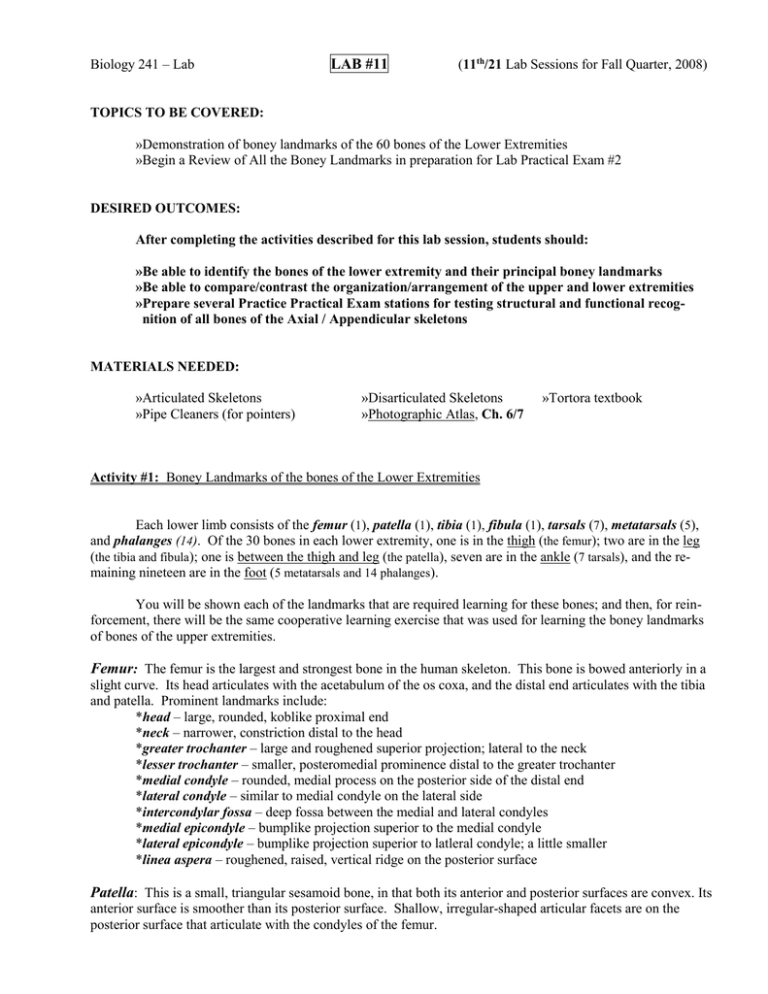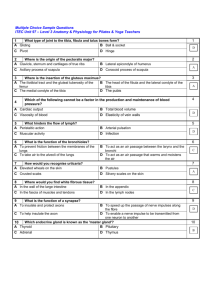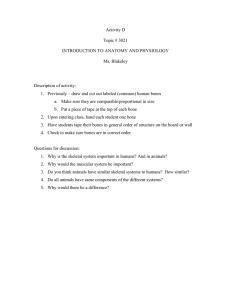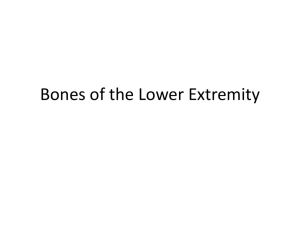LAB #11
advertisement

Biology 241 – Lab LAB #11 (11th/21 Lab Sessions for Fall Quarter, 2008) TOPICS TO BE COVERED: »Demonstration of boney landmarks of the 60 bones of the Lower Extremities »Begin a Review of All the Boney Landmarks in preparation for Lab Practical Exam #2 DESIRED OUTCOMES: After completing the activities described for this lab session, students should: »Be able to identify the bones of the lower extremity and their principal boney landmarks »Be able to compare/contrast the organization/arrangement of the upper and lower extremities »Prepare several Practice Practical Exam stations for testing structural and functional recognition of all bones of the Axial / Appendicular skeletons MATERIALS NEEDED: »Articulated Skeletons »Pipe Cleaners (for pointers) »Disarticulated Skeletons »Photographic Atlas, Ch. 6/7 »Tortora textbook Activity #1: Boney Landmarks of the bones of the Lower Extremities Each lower limb consists of the femur (1), patella (1), tibia (1), fibula (1), tarsals (7), metatarsals (5), and phalanges (14). Of the 30 bones in each lower extremity, one is in the thigh (the femur); two are in the leg (the tibia and fibula); one is between the thigh and leg (the patella), seven are in the ankle (7 tarsals), and the remaining nineteen are in the foot (5 metatarsals and 14 phalanges). You will be shown each of the landmarks that are required learning for these bones; and then, for reinforcement, there will be the same cooperative learning exercise that was used for learning the boney landmarks of bones of the upper extremities. Femur: The femur is the largest and strongest bone in the human skeleton. This bone is bowed anteriorly in a slight curve. Its head articulates with the acetabulum of the os coxa, and the distal end articulates with the tibia and patella. Prominent landmarks include: *head – large, rounded, koblike proximal end *neck – narrower, constriction distal to the head *greater trochanter – large and roughened superior projection; lateral to the neck *lesser trochanter – smaller, posteromedial prominence distal to the greater trochanter *medial condyle – rounded, medial process on the posterior side of the distal end *lateral condyle – similar to medial condyle on the lateral side *intercondylar fossa – deep fossa between the medial and lateral condyles *medial epicondyle – bumplike projection superior to the medial condyle *lateral epicondyle – bumplike projection superior to latleral condyle; a little smaller *linea aspera – roughened, raised, vertical ridge on the posterior surface Patella: This is a small, triangular sesamoid bone, in that both its anterior and posterior surfaces are convex. Its anterior surface is smoother than its posterior surface. Shallow, irregular-shaped articular facets are on the posterior surface that articulate with the condyles of the femur. Biology 241 – LAB #11 – continued Page Two Tibia: The tibia is the weight-bearing bone of the two leg bones and is medially located. Laterally, the tibia forms a joint with the fibula. The prominent landmarks of the tibia include: *medial condyle – flattened, expanded medial projection on the proximal end *lateral condyle – similar to the medial condyle only on the lateral side *intercondylar eminence – an upward, bifid projection separating the medial and lateral condyles *tibial tuberosity – large, roughened projection of the anterior surface, inferior to the condyles. *anterior border (crest or “shin”) – slender ridge on the anterior surface *medial malleolus – medial process on the distal end; forms the medial “bump” of the ankle Fibula: The slender fibula is the lateral leg bone (the fibuLA lies LAteral is a mnemonic device to help remember the relative positions of the tibia and fibula in the leg) that is important for muscle attachment but not for bearing weight. The head of the fibula is proximal and articulates with the tibia, but not with the femur. (Thus, the fibula is not part of the knee joint.) The lateral malleolus is distal and articulated with the talus laterally. The only two landmarks you should know are: *head – proximal end *lateral malleolus – distal end; forms the lateral “bump” of the ankle Ankle (aka Tarsus): The tarsus is composed of seven tarsal bones of the foot, with two of them being larger than the rest. The largest tarsal bone is the calcaneus, also known as the heel bone. The other large tarsal bone is the talus, which articulates with the tibia and fibula. The other tarsal bones include the navicular, the 1st, 2nd, and 3rd cuneiforms, and the cuboid. (See your Osteology sheet for a mnemonic device for helping you to remember the names of the seven tarsal bones.) Metatarsus: The metatarsus is composed of five metatarsal bones that are analogous to the metacarpals in the hand. They are numbered the same way (using Roman Numerals), from I to V, starting medially with the great toe to and proceeding laterally to the little toe. Phalanges (aka Toes): The phalanges (toes or digits of the foot) are similar to the phalanges in the hand. The toes are numbered I to V from the great toe (hallux) to the little toe. The great toe is composed of two phalanges (proximal and distal), and digits II through V have three phalanges each – proximal, middle, and distal. As we did before, for this cooperative learning exercise, you will work in groups of 4 – 5 students. Each group will be given either a femur, tibia, fibula, or an articulated foot (including tarsals.) Each student in each group will spend approximately 3 – 5 minutes learning the assigned sstructures on his/her own, using the Photographic Atlas, the textbook rendition of that bone, or the bone itself. One member of the group will act as “Spokesperson” And will tell whether the bone is a R or a L, along with a rationale; ALL students should follow along and make corrections as necessary. The bones with their assigned structures are now rotated clockwise, so that each group has a new set of structures to learn and to practice. With each new bone, a different student should volunteer to be “spokesperson” to first present the rationale for whether the bone is a R or a L and to identify all landmarks. The rotation of bones is repeated until each student has been the Spokesperson at least once. Activity #2: Review the Bones and Boney Landmarks of all the bones If you have time remaining in today’s lab session after completing Activity #1, then begin your review for Lab Practical Exam #2. It might work best to work in pairs or in groups to set up practice practical exam questions – using the format of the practice practical exam “stations” that have been set out during each of our bone labs. By making up stations yourselves, your learning will be reinforced by doing!!


